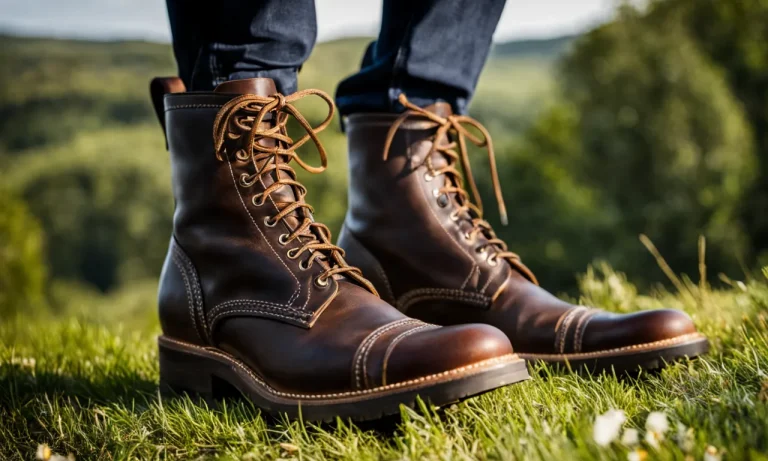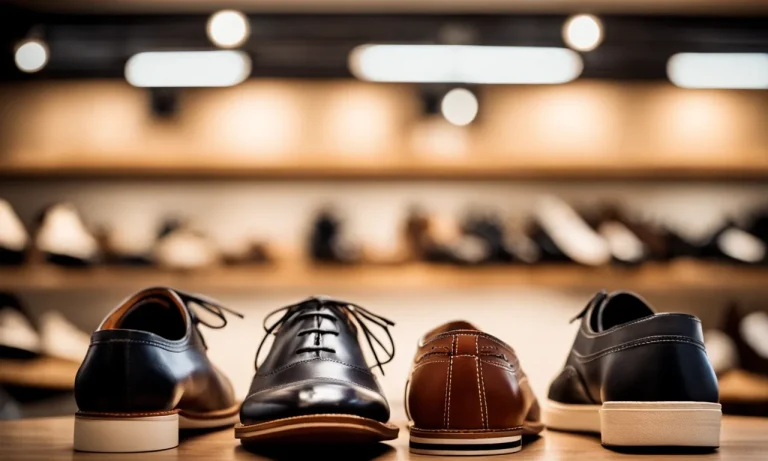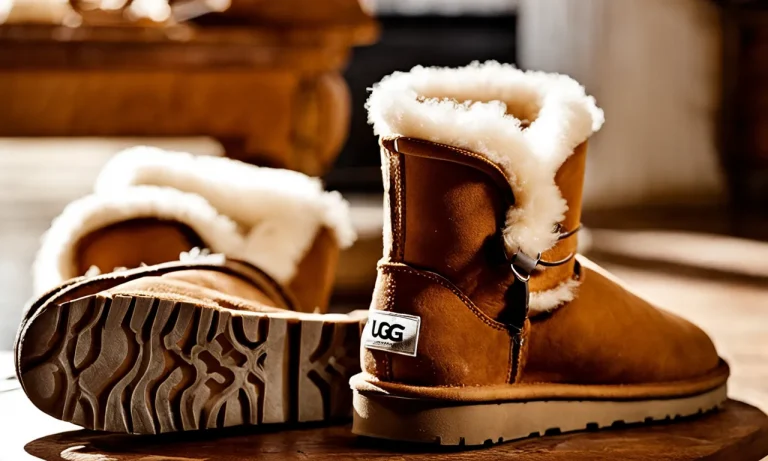If you work in an industry like construction, manufacturing, or law enforcement, you know the importance of wearing protective footwear on the job. Composite toe boots are a popular choice for their lightweight yet tough protection.
In this comprehensive guide, we’ll explain everything you need to know about composite toe boots.
If you’re short on time, here’s a quick answer to your question: Composite toe boots have protective toe caps made from non-metallic materials like carbon fiber, fiberglass, Kevlar, or plastic. They offer impact and compression protection like steel toes, but are lighter in weight and don’t conduct temperature.
What is a Composite Toe?
A composite toe is a safety feature found in certain types of work boots. It is designed to protect the wearer’s toes from heavy objects, compression, and impact. Unlike traditional steel toe boots, composite toe boots are made from non-metallic materials, such as Kevlar, carbon fiber, or fiberglass.
These materials are lightweight, yet still provide the necessary protection.
Composite Toe Construction
The construction of composite toe boots involves layering multiple materials together to create a strong and durable toe cap. The layers are typically made from a combination of fiberglass, Kevlar, and carbon fiber.
These materials are carefully chosen for their strength and ability to withstand high impact forces.
Materials Used
The specific materials used in composite toe boots may vary depending on the brand and model. However, the most common materials include:
- Fiberglass: Known for its strength and lightweight properties, fiberglass is a popular choice for composite toe construction.
- Kevlar: This synthetic fiber is five times stronger than steel, making it an excellent choice for toe protection.
- Carbon Fiber: Highly durable and lightweight, carbon fiber adds strength to the composite toe cap.
Benefits of Composite Toes
Composite toe boots offer several advantages over traditional steel toe boots:
- Lightweight: Composite toe boots are generally lighter than steel toe boots, making them more comfortable to wear for extended periods.
- Non-Metallic: Since composite toe boots do not contain metal, they are non-conductive and do not set off metal detectors.
- Thermal Insulation: Unlike steel, composite materials do not conduct temperature, providing insulation against extreme hot or cold conditions.
- Electrical Hazard Protection: Composite toe boots offer electrical hazard protection, reducing the risk of electric shock.
Safety Ratings Explained
When purchasing composite toe boots, it’s important to consider their safety ratings. These ratings are determined by organizations such as the American Society for Testing and Materials (ASTM) and indicate the level of protection provided by the boots. Common safety ratings include:
| Safety Rating | Description |
|---|---|
| ASTM F2413-11 | This standard specifies minimum requirements for the design, performance, testing, and classification of protective footwear. |
| EH | Electrical Hazard protection, indicating the boots provide a secondary source of electric shock resistance. |
| SD | Static Dissipative, meaning the boots are designed to reduce static electricity buildup. |
It is important to choose composite toe boots that meet or exceed the safety requirements of your specific work environment.
Comparing Composite Toe vs Steel Toe
Weight Difference
One significant difference between composite toe boots and steel toe boots is the weight. Steel toe boots are typically heavier due to the metal reinforcement in the toe area. On the other hand, composite toe boots are made from non-metal materials such as carbon fiber, Kevlar, or fiberglass, making them much lighter in weight.
This can be a great advantage for workers who are on their feet all day and need to minimize fatigue.
Thermal Properties
When it comes to thermal properties, steel toe boots tend to conduct heat and cold more easily. This means that in extreme temperatures, the steel reinforcement can become uncomfortably hot or cold, depending on the environment.
In contrast, composite toe boots offer better insulation and are not affected by temperature variations as much as steel toe boots. This makes them more suitable for workers who are exposed to extreme weather conditions.
Electrical Conductivity
Steel toe boots are conductive to electricity, which can be a safety hazard in certain work environments. In contrast, composite toe boots are non-conductive and provide better protection against electrical hazards.
This makes them a preferred choice for workers in industries such as construction, electrical, and manufacturing, where the risk of electrical shock is higher.
Puncture Resistance
Both composite toe and steel toe boots offer some level of puncture resistance; however, composite toe boots have the advantage in this aspect. The non-metal materials used in composite toe boots, such as Kevlar, provide excellent protection against punctures from nails, sharp objects, or heavy machinery.
This makes them a popular choice for workers in industries where the risk of puncture injuries is high.
Which is Better?
Choosing between composite toe boots and steel toe boots ultimately depends on the specific needs and preferences of the worker. Steel toe boots are known for their durability and strength, making them suitable for heavy-duty work environments.
On the other hand, composite toe boots offer lighter weight, better insulation, and non-conductivity, making them more comfortable and safer in certain situations. It’s important to consider the work environment, potential hazards, and personal preferences when making a decision.
Types of Composite Toe Boots
Soft Toe
Soft toe composite boots are designed for those who work in non-hazardous environments. They provide protection against common workplace hazards like slips, falls, and impacts. These boots are lightweight and comfortable, making them perfect for all-day wear.
They are also non-metallic, which means they won’t set off metal detectors.
Steel Toe
Steel toe boots are the most common type of composite toe boots. They are made with a steel cap in the toe area, which provides excellent protection against heavy falling objects and compression. Steel toe boots are known for their durability and ruggedness, making them ideal for construction workers and those in heavy industries.
Alloy Toe
Alloy toe boots are similar to steel toe boots but are made with a lightweight metal alloy instead of steel. This makes them lighter and more comfortable to wear without compromising on protection. Alloy toe boots are a popular choice for those who need safety footwear for long hours of work.
Carbon Fiber Toe
Carbon fiber toe boots offer the same level of protection as steel toe boots but are much lighter and non-metallic. They are ideal for those who work in high-security areas where metal detectors are used.
Carbon fiber toe boots are also highly resistant to temperature changes, making them suitable for extreme weather conditions.
Fiberglass Toe
Fiberglass toe boots are another lightweight and non-metallic option for toe protection. They are known for their electrical resistance, making them a great choice for electricians or anyone working with live electrical circuits.
Fiberglass toe boots are also non-conductive and provide excellent insulation against heat and cold.
Comparing Materials
When it comes to choosing the right composite toe boot, it’s important to consider the material used. Steel toe boots offer the highest level of protection but can be heavy and may set off metal detectors. Alloy toe boots provide a good balance between protection and weight.
Carbon fiber and fiberglass toe boots are lightweight and non-metallic, making them suitable for high-security areas. Ultimately, the choice of material depends on the specific needs and preferences of the wearer.
For more information on composite toe boots and safety footwear, you can visit websites like OSHA or Safe Work Australia. These websites provide comprehensive guidelines and regulations for workplace safety.
Features to Look for
When it comes to choosing the right composite toe boots, there are several important features to consider. These features not only enhance safety but also ensure comfort and durability. Here are some key features to look for:
Safety Ratings
One of the most crucial aspects of composite toe boots is their safety ratings. Look for boots that meet or exceed industry standards, such as ASTM F2413-18 or ANSI Z41. These ratings ensure that the boots provide adequate protection against impact and compression.
Additionally, some boots may have additional safety features like electrical hazard protection or metatarsal guards.
Slip Resistance
Slips and falls can be a common hazard in various work environments. To minimize the risk, choose composite toe boots with excellent slip resistance. Look for boots with outsoles made from materials like rubber or polyurethane that offer superior traction on different surfaces.
Boots with specialized tread patterns or slip-resistant technology can further enhance stability and grip.
Waterproofing
Working in wet or damp conditions can make your feet uncomfortable and increase the risk of certain foot conditions. Therefore, it is essential to select composite toe boots with effective waterproofing features.
Look for boots with waterproof membranes like Gore-Tex or Dri-Lex that keep your feet dry while allowing moisture to escape, preventing sweat buildup and maintaining breathability.
Insulation
In cold weather conditions, insulation is vital to keep your feet warm and comfortable. Look for boots with insulation materials like Thinsulate or PrimaLoft, which provide excellent thermal protection.
The insulation should be sufficient to withstand the temperatures you will be working in, ensuring that your feet stay warm and cozy throughout the day.
Fit and Comfort
A pair of composite toe boots can have all the right safety features, but if they don’t fit properly or are uncomfortable, they won’t be much use. Look for boots that offer a snug fit without being too tight or too loose.
Consider features like cushioned insoles, padded collars, and ergonomic designs that provide all-day comfort. It’s also a good idea to try on different brands and models to find the one that suits your feet best.
Remember, choosing the right composite toe boots is essential for your safety and comfort in the workplace. By considering these key features, you can find a pair that meets your needs and provides reliable protection throughout the day.
Care and Maintenance Tips
Breaking In New Boots
When you first get a pair of composite toe boots, it’s important to break them in properly. This will ensure that they are comfortable to wear and will help prevent blisters or discomfort. Start by wearing them for short periods of time and gradually increase the duration as your feet become accustomed to the boots.
You can also try using thick socks or using a boot stretcher to help accelerate the breaking-in process. Remember, taking the time to properly break in your boots will pay off in the long run.
Cleaning
To keep your composite toe boots in great condition, regular cleaning is essential. Start by removing any loose dirt or debris from the surface of the boots. Use a soft brush or cloth to gently scrub away any stains or marks.
For tougher stains, you can make a mild cleaning solution using water and a mild soap. Avoid using harsh chemicals or abrasive materials, as these can damage the boots. After cleaning, allow the boots to air dry naturally.
Remember to check the manufacturer’s instructions for any specific cleaning recommendations.
Storing Boots
Properly storing your composite toe boots can help prolong their lifespan. Make sure to store them in a cool, dry place away from direct sunlight. Avoid placing heavy objects on top of the boots, as this can cause them to lose their shape.
If possible, store them in a boot tree or use rolled-up newspaper to help maintain their shape. Additionally, consider using a boot bag or box to protect them from dust or moisture.
Inspecting for Damage
Regularly inspecting your composite toe boots for any signs of damage is important for both your safety and the longevity of the boots. Check for any cracks, tears, or loose stitching. Pay close attention to the composite toe area, as it is important for protecting your toes.
If you notice any damage, it is best to have the boots repaired or replaced as soon as possible. This will help prevent any further damage and ensure that your boots continue to provide the necessary protection.
Replacing When Needed
Composite toe boots are designed to provide protection for a certain period of time. However, they will eventually wear out and lose their effectiveness. It is important to monitor the condition of your boots and replace them when necessary.
Signs that your boots may need replacing include significant wear and tear, cracks in the composite toe area, or a loss of flexibility. Don’t wait until it’s too late – investing in a new pair of boots is crucial for maintaining your safety on the job.
Top Composite Toe Boot Brands
Timberland PRO
Timberland PRO is a well-known brand when it comes to composite toe boots. They offer a wide range of durable and comfortable boots that are perfect for those who work in hazardous environments. Timberland PRO boots are designed to provide maximum protection without compromising on style.
Whether you’re working on a construction site or in a warehouse, Timberland PRO boots are a great choice.
Wolverine
Wolverine is another top brand that produces high-quality composite toe boots. With over 135 years of experience, Wolverine has established itself as a trusted name in the industry. Their boots are known for their durability, comfort, and superior protection.
Whether you’re working in extreme weather conditions or rough terrains, Wolverine boots are designed to keep your feet safe and comfortable throughout the day.
Thorogood
Thorogood is a brand that has been around for over 125 years, and they are known for their exceptional craftsmanship and quality. Their composite toe boots are no exception, providing excellent protection and comfort.
Thorogood boots are made with high-quality materials and are designed to withstand the toughest conditions. If you’re looking for a reliable and durable pair of composite toe boots, Thorogood is a brand worth considering.
Caterpillar
Caterpillar, also known as CAT, is a brand that is synonymous with heavy-duty equipment and machinery. They have extended their expertise into the footwear industry, producing top-of-the-line composite toe boots.
Caterpillar boots are known for their durability and ruggedness, making them ideal for those working in construction or industrial settings. With their innovative design and advanced safety features, Caterpillar boots provide the ultimate protection for your feet.
Justin Original Work Boots
Justin Original Work Boots is a brand that combines traditional craftsmanship with modern technology. Their composite toe boots are designed to provide superior comfort and protection. Justin Original Work Boots are made using high-quality materials and innovative construction techniques.
These boots are not only functional but also stylish, making them a popular choice among workers in various industries.
Carhartt
Carhartt is a brand that is known for its rugged and durable workwear. They have extended their expertise into the footwear industry, producing top-quality composite toe boots. Carhartt boots are designed to withstand the toughest conditions and provide maximum protection.
With their focus on durability and comfort, Carhartt boots are a great investment for anyone working in demanding environments.
Conclusion
Composite toe boots offer an excellent blend of safety, comfort, and performance. While they have slightly less puncture resistance than steel toes, composites are much lighter in weight and won’t conduct heat or cold.
Look for boots with the right safety ratings for your work environment and requirements. Prioritize fit, slip resistance, support, and comfort features as well. With proper care, high-quality composite toe boots can protect your feet for years on the job.






